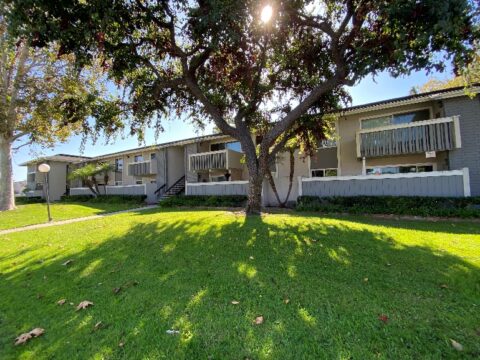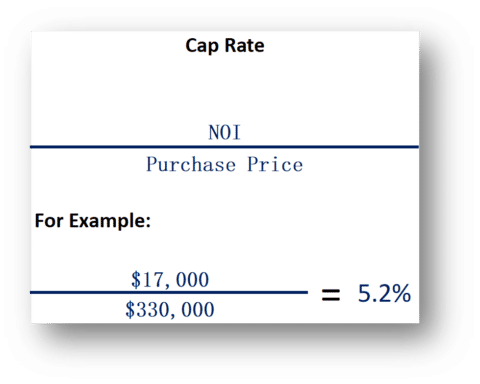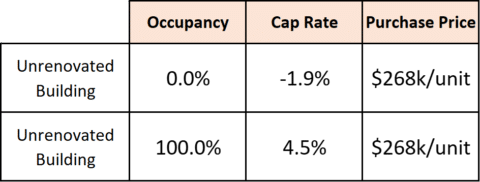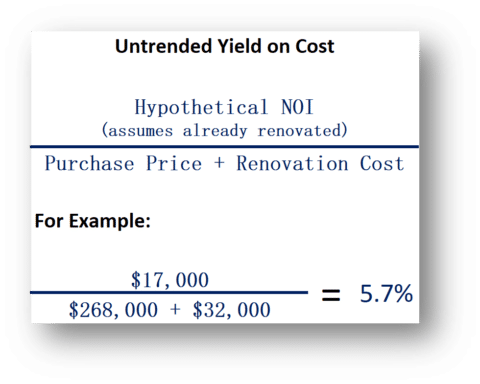Misconceptions in Commercial Real Estate – The Truth About High IRR Return Projections

I recently encountered a buyer who was planning to acquire a
rather old apartment building, intending to renovate it entirely, and then to
re-lease it at higher rents. The buyer had estimated an IRR (Internal Rate of
Return, equivalent to the annualized return on investment) of 15.1% per annum
over a five-year holding period, which is relatively attractive for value-add
projects of this type. However, after learning more about this investment
project, I had doubts about the IRR result and the proposed purchase price.
After analysis, I recommended the buyer to renegotiate with the seller before
investing.

professionals generally will not base commercial real estate pricing solely on
IRR, as it can too easily lead to overpaying for property. Below I introduce
two methods commonly used by professionals to quickly evaluate the investment
value of commercial real estate projects and avoid the pitfalls of misleading
IRR estimates. An apartment building is used as an example here; however, the
same methods can be used for virtually all types of commercial real estate,
including industrial, office, retail, hotel and others.
Method
One: Compare with Already Renovated Real Estate
Buying or Selling a Home? We Can Help
The buyer asked for my help, and after researching the local
market, I discovered another apartment building located in the same area that
was very similar to the one he planned to purchase. Both were of the same
vintage, had similar unit layouts, and were generally comparable. The only main
difference was that the building I found had recently been renovated and had
already been fully re-leased at current market rental prices. Although, the
asking price per unit of the renovated apartment building ($330,000 per unit)
was higher than the per unit price the buyer had negotiated on the unrenovated
building ($300,000 per unit), it was estimated that renovations would cost
$32,000 per unit, thus the total cost to purchase and renovate the unrenovated
building would actually be slightly higher than the cost to simply purchase the
already renovated building. As both buildings would likely have similar market
values post renovation, it follows that the total cost to purchase and renovate
($332,000 per unit) would likely be higher than the market value after
renovation ($330,000 per unit). In other words, the renovation itself would be
a losing investment.

This begs the question, if renovating the building results in
a loss, how did the buyer estimate such a high IRR of 15.1%? The answer is that
his IRR return estimate resulted from the combination of optimistic future rent
growth assumptions and the effect of high leverage, but not from the planned
renovation. Thus, it follows that, assuming these assumptions and leverage
projections are accurate, if the buyer were instead to acquire the already
renovated apartment building, the same high market rent growth and high debt
leverage would result in an even higher IRR of 15.5%, without the trouble of
renovating.
Because renovation carries risks, higher returns are
generally required for a renovation project. In the above example, however, the
IRR was lower for the renovation project. When this happens, it is likely
because the purchase price of the unrenovated apartment building is too high.
At the same time, the estimated rent growth rate was rather optimistic (perhaps
overly so), resulting in an IRR that still appears attractive, despite incurring
losses on the renovations. Thus, when estimating a purchase price, it is
important to temporarily ignore IRR, and focus on the total project cost.
If it were possible to purchase the unrenovated apartment
building for just $268,000 per unit, the total cost including renovation
expenses would be $300,000 per unit. As the market value post renovation is
expected to be $330,000 per unit (before considering any market rent growth),
undertaking the renovation would result in a 10% increase in value. Thus, by
most investment standards, it would be an attractive investment property with
the potential to add value through renovation.

Using this total cost comparison method to calculate return
on value, results are unaffected by assumptions about future rent growth or
potential loan leverage. If rent growth and leverage costs deviate from initial
assumptions, this will still not affect the increase in value that results from
successfully executing the renovation. However, IRR is different. In the above
scenario, assuming a purchase price of $268,000 per unit, the resulting IRR
would be 21.3%. However, if the rent
growth and debt leverage assumptions turn out to be overly optimistic, actual
IRR results will be much lower. For example, assume a market downturn is
encountered after purchase, resulting in a drop in market value to $310,000 per
unit post renovation, followed by flat rent growth.

If the already renovated building had been purchased for
$330,000 per unit, the market downturn would result in loss of $20,000 per
unit. However, if the unrenovated building had been purchased at a total cost
of $300,000 including purchase and renovation costs, the renovation might still
achieve a $30,000 per unit increase in value. Combined with the $20,000 loss
due to the market downturn, this would result in a net profit of $10,000 per
unit. Regardless of which building is
purchased, both would incur similar losses due to the market downtown, however
undertaking the renovation adds value independent of swings in the market.
Comparing unrenovated real estate with similar, already
renovated real estate is a common pricing method for value-add projects, but
this method also has many flaws, including:
1. It
can often be difficult to find already renovated projects that are similar, or
sales price data may not be available.
2. Even
if some sales price data is available, it may not reflect market prices.
3. Commercial
real estate generally places more emphasis on the valuation of cash flows.
Therefore, professionals in the US commercial real estate
industry often tend to place more emphasis on method two below.
Method
Two: Estimate the Untrended Yield-on-Cost
The untrended yield-on-cost is
commonly used to price renovation projects.
It is similar to the capitalization rate (cap rate), however different
in important respects. For real estate projects that do not require significant
renovation, the cap rate is commonly used to estimate or validate market value.
The cap rate of the investment project is estimated by dividing annual net
operating income (NOI) by the purchase price or market value of the project.
This project cap rate is then compared to the cap rate for similar properties
on the market, or it is compared to “market cap rates” reported by real estate
companies.

In the above example, the cap rate of the renovated apartment
building was 5.2%. If it is assumed that the market cap rate was also 5.2%,
then the price may be considered reasonable. If instead the market cap rate
were lower than 5.2%, this would indicate that the renovated apartment building
may be priced below market, i.e. at a discount. Nonetheless, it should be noted
that the cap rate of a specific investment project and the market cap rate are
somewhat subjective judgments, and the characteristics of the project (such as
maintenance condition, age of the building, location, length of lease
contracts, tenant quality, etc.) will generally result in variance in the cap
rate. Therefore, the cap rate tends to be a quick and dirty method and cannot
completely replace more in-depth analysis, especially for non-standard
projects.
However, for value-add projects, the cap rate is generally
meaningless, as it does not consider renovation costs or the increase in rents
that results from the renovation, among other things. As such, it does not
reflect the potential of value-add projects and will not produce accurate value
estimates. For example, a completely vacant building will have a cap rate of
zero or even less, due to carry costs such as property taxes, insurance,
maintenance, etc. Conversely, if the exact same building were fully leased out,
its cap rate could be relatively high. However, assuming both are value-add renovation
projects, the pricing is unlikely to be affected much by the current vacancy
rate, i.e. they will be sold at similar prices, because their value is not
derived from existing net cash flows, but rather determined by the potential
future cash flows following renovation.

To address issues with the cap rate, one method industry
professionals typically use is to estimate the untrended
yield-on-cost, which is calculated similarly to the cap rate, but with some key
differences. The untrended yield-on-cost assumes that
the project has already been renovated, then estimates the potential
unleveraged annual NOI achievable based on hypothetical market rents for the
post-renovation building at the time of purchase, and then calculates the ratio
of this hypothetical NOI to the total cost of the project, i.e. the cost to purchase and renovate the project.

In reality, because applying for construction permits, evicting tenants, construction, leasing, etc., all take time, the NOI achieved
after renovation will not only increase as a result of the renovation, it will
also fluctuate with the rental market and other factors. However, in order to
more clearly differentiate the value added by renovation from any assumptions
about future rent growth in the market, it is recommended to calculate the untrended yield-on-cost based on hypothetical current
market rents at the time of purchase, even though renovations may not be
completed until much later.
For projects that do not undergo renovation, the cap rate and
the untrended yield-on-cost will always yield the
same results. However, for value-add renovation projects, the untrended yield-on-cost is generally required to be
substantially higher than the market cap rate. In the above example, the market
capitalization rate of the renovated apartment building is 5.2%, indicating
that purchasing an already renovated apartment building should be able to
achieve a NOI equal to 5.2% of the total purchase price. However, if purchasing
the building that requires renovation, then NOI equal to at least 5.7% should
be achievable, calculated as a percentage of the total cost to purchase and
renovate the building.
This additional 0.5% of NOI represents the value added by
renovation. Commercial real estate is commonly priced based on NOI, and this
0.5% is equivalent to approximately 10% appreciation in market value. This
appreciation is independent of future market rent increases or debt leverage.
It only reflects the appreciation brought by renovation. In the above example,
only if the cost to purchase and renovate the apartment building is $300,000
per unit or less, can an untrended yield-on-cost that
is 0.5% higher than the market cap rate be achieved.

It should be noted that the percentage of required additional
NOI will vary depending on the extent of the renovation and the market cap
rate. In markets with cap rates around 5%, investors will typically target an untrended yield-on-cost approximately 0.5%-1.0% higher for
a renovation, and about 1.0% higher for more extensive renovation or ground up
construction. However, when the market
cap rate is higher, these percentages will generally increase
proportionately. For example, a project
with a 10% market cap rate may require an 11%-12% untrended
yield-on-cost.
Thus, it can be seen that estimating the untrended
yield-on-cost can help show the true value added by renovation and help us to
accurately price commercial buildings in need of renovation. Conversely, a high
IRR may just be the result of unreasonable rent growth assumptions or high debt
leverage assumptions and can potentially mislead buyers and investors to
overpay for commercial real estate and pursue unprofitable renovation projects.

